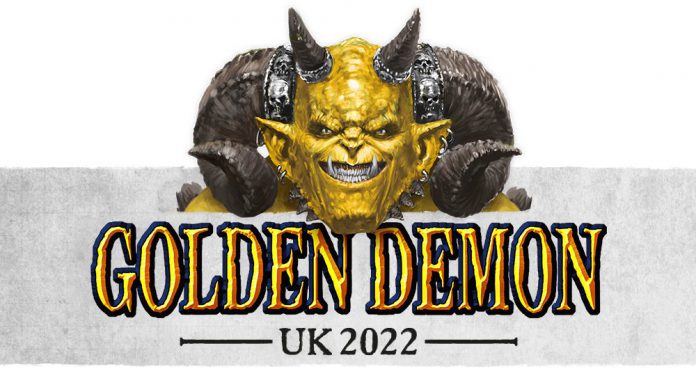October’s Golden Demon held in the UK was special for two reasons: it was the first held in the country for a few years due to the pandemic and marked the 35th anniversary of the competition.
Soggy and Bair were on the ground and are here with a series of articles and interviews showing different aspects and perspectives of the event. For a bit of history or context, click here.
We were fortunate enough to interview hobby titan Richard Gray, who has multiple Slayer Swords to his name!
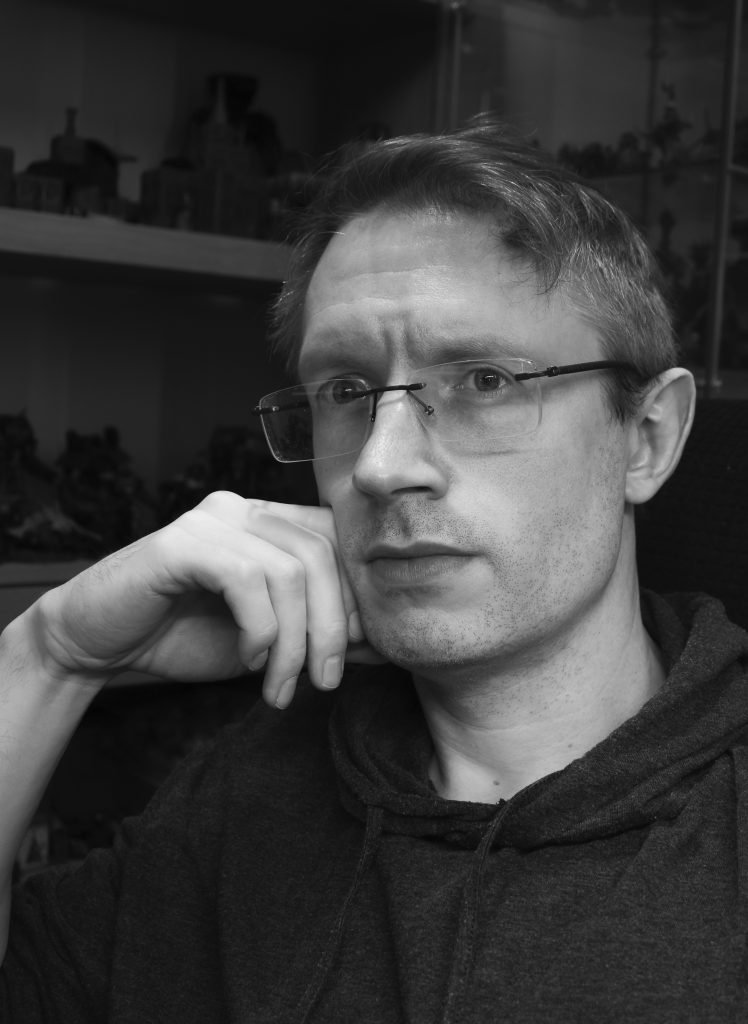
GH: Thank you so much for speaking to us! To start things off – for people who aren’t familiar with the painting scene, Could you introduce yourself and tell us what brings you to Golden Demon today?
RG: I work a lot on social media doing painting competitions all the time, and have won quite a few trophies. So people know me for my painting. I’ve come today to enter and to see all the other Golden Demon painters because there’s some amazing painters here. It’s really good because you get to like swap tips and things and just see each other’s models because the thing is you tend to see them online, so it’s really nice to see them in the flesh as well.
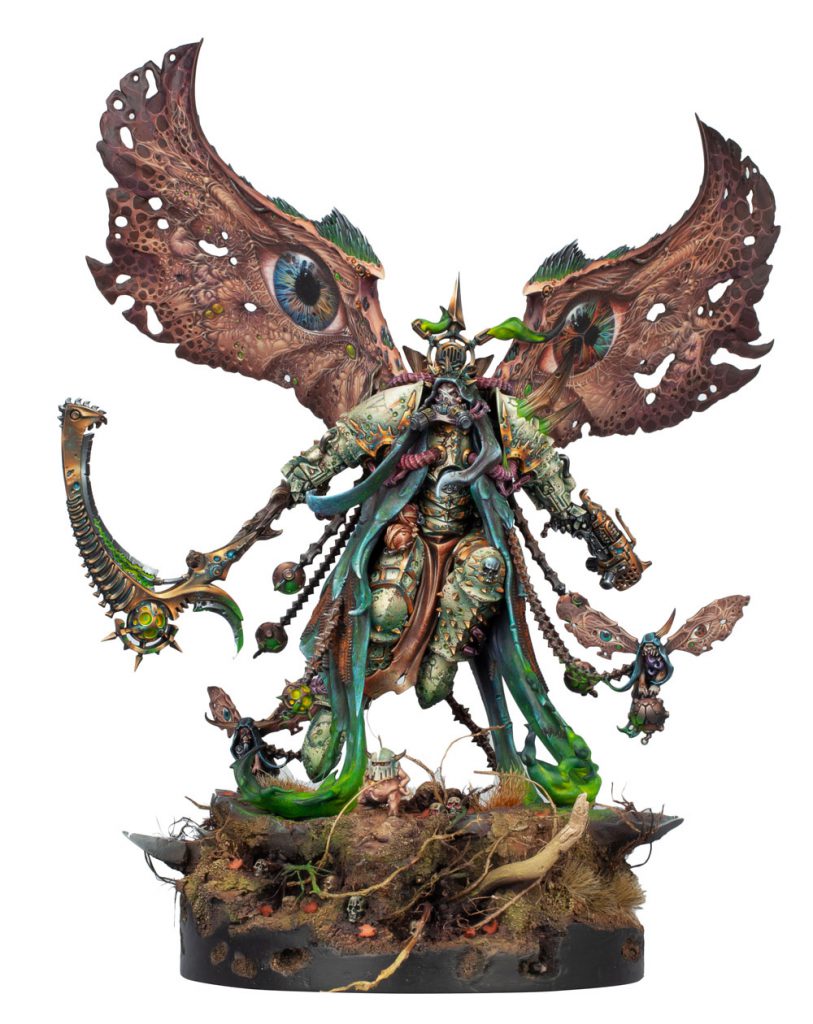
GH: How are you feeling? And what’s it like being back to Golden Demon after so long?
RG: It was quite nerve wracking actually because before, when I was doing it, I was doing it regularly. But then having that break after Covid, kind of like you get out of the habit and you don’t see a lot of people either. So all of a sudden it’s a lot of people all at once and people have also saved up all of their entries that have been painting away. And so the standard for this is very high, the only thing is there’s not as many entries because there’s a limited capacity which is one of the negatives about having it here.
But I think most of the well known painters, the only thing is that it’s a bit awkward if somebody wants to compete for the first time, they could be an amazing painter, but they might not have been quite so on the ball for getting the tickets – and you know, that makes it a bit, it’s not such a good competition in that regard.
GH: What motivates you to do Golden Demon and has that changed over time?
RG: Yeah, it has changed – well it’s quite a long story actually because I started doing Golden Demon when I was a teenager, and I’m 42 now. So I got my first Golden Demon trophy in 1999 and every year I was desperate to get a trophy. I loved the White Dwarfs with all the Gold Demon entries in and that was my aim, I really wanted to do that.
As soon as I achieved that I kind of went off it a bit, and the desire wasn’t there any more as such, I just carried on just army painting or just painting for fun. But after a while I kept looking online – for a start online wasn’t a thing when I was doing it – but as online became more of a thing, I was looking at people’s painting and thinking that I could, I could do that and have a go.
So I thought, right, I want another go at it. And the first Golden Demon I did, it was in 2014 and my aim was to get a pin and that’s when I won the Slayer Sword. That set my route after that because you get a lot of attention as soon as you win a Sword.
GH: Would you say that painting has always been the focus of your hobby or is that really changed over time?
RG: I think that’s changed over time. When I was younger I was really into the gaming, massive armies. I still have that bad habit. Every time something new comes out I buy the army for it, but it doesn’t get used. That’s the problem – I don’t have time to game very much, because I’m painting all the time, making videos and all that kind of stuff, which is a bit sad. I do wish I could game a bit more. But my main passion is painting because that was my background as well – I trained as an illustrator, so art is my thing.
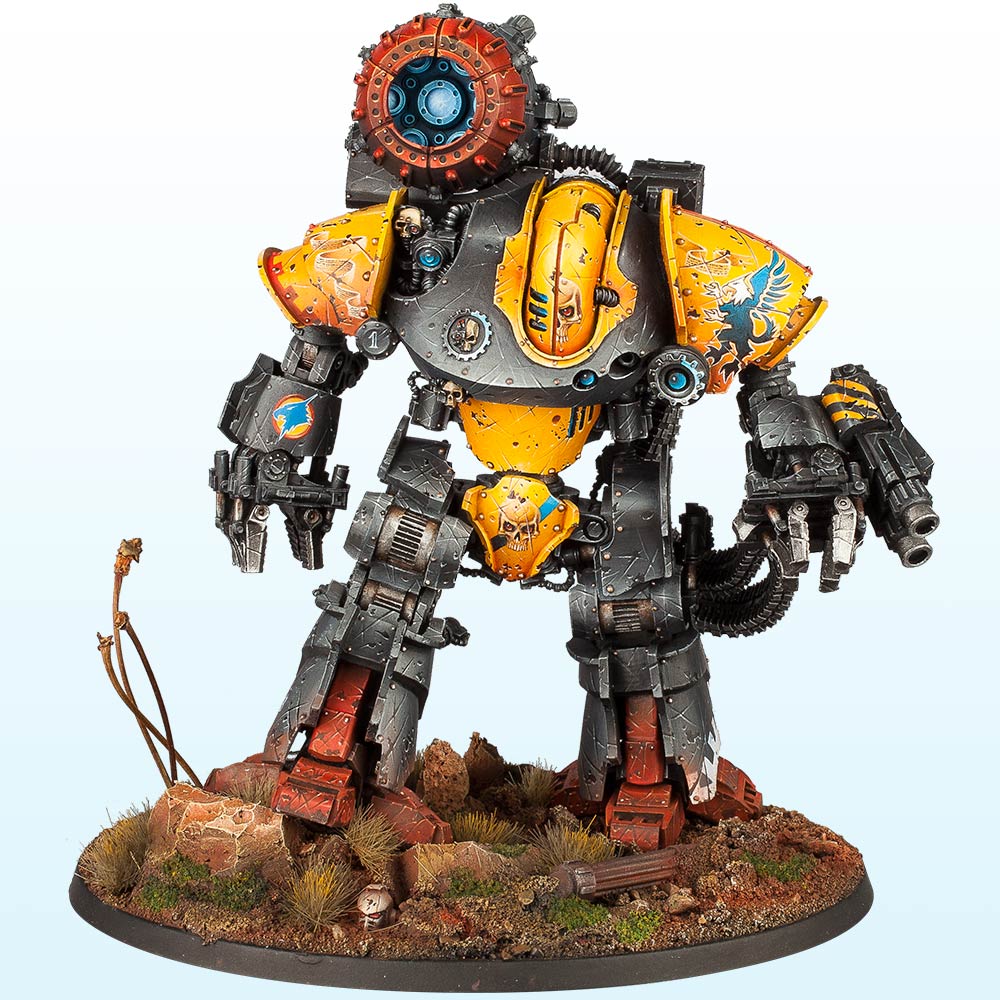
GH: As a Golden Demon winner, and as a Slayer Sword winner – what was it like getting your first Slayer Sword?
RG: It blew my mind. I was so shocked because I’d been struggling a little bit. My mum at the time was dying of cancer and I was like I was having a really rough time. I was trying to do commission painting as well and I thought right, it’s hard to make money and be super successful then. So I thought, all right, I’m going to enter this and if I don’t get a pin then I’m just going to stop commission painting. And then you know – I’ve got the sword and it was like, I just couldn’t – no trophy since then has matched up because it was such an unbelievable thing for me because I got the Forge World best of show at the same time as well and that hadn’t been done before.
I was walking on cloud nine. It was so amazing and then that just set me up because you get so much attention, people start commissioning you a lot more when you get well known. Then that just snowballs from there because you can keep adding more and more painting. People pay you more so you can do better painting and then you enjoy that. So you just focus on that kind of high level painting, which is something that you really only tend to be able to do when you’re well known. From there, Patreon became a thing and YouTube and everything. So it set me up so well that first win.
GH: So after winning a Slayer Sword like that, how do you up your game to the next level?
RG: It gets a little bit tricky to up your game because there’s always something new to learn and loads of styles – and actually it is quite interesting because a lot of art is coming in from other media as well. You see old classic oil paintings and things and people are taking that kind of style and then putting that onto models and it’s a lot harder to make that work because it tends to only work from certain angles. The challenge becomes to make the model look good all the way around even while having that dramatic lighting.
People are doing non-metallic metals – which is kind of a side thing as well, because it’s only within model painting that we call it non-metallic metal. It’s nonsense really – because like all painting – you get reflections and things off of all surfaces, just depending on what’s more shiny or less shiny or reflective. So it always makes me laugh that model painters think non-metallic is a specific thing. No, it’s not, it’s just painting. So there’s lots of different areas you can always push to improve in but in terms of brush skill and refinement, it’s hard to get any higher. There’s a limit to how much you can do with the paint in terms of making it a neat piece.

GH: So with all the focus on painting, do you still actively collect or play any games or systems?
RG: Yes, so I do Adeptus Titanicus. I love Titanicus.
[Soggy and Bair start immediately punching the air]
When I’m not doing videos, I’m always trying to build another titan. I’m desperate when I see something coming out and I think – oh maybe Games Workshop will send me one! It is kind of weird as well because they’re not things that I spend quite as much time painting, they’re not painting pieces for me – they’re gaming pieces. I still still spend a bit of time on them and make them look nice, but I just, I love the titans, it’s so cool.
GH: So now that you’re here, could you talk us through your entries?
RG: So I’ve got one main entry which is a Loon Boss on Squig Hopper. So from the Gloomspite Gitz, that was originally going to be for AdeptiCon in 2019 or 2020. But they canceled that and I hadn’t finished it, Covid was kicking up, everything went bad, and I lost motivation to finish it. So it was half done. Then this Golden Demon was coming up – a few of my friends were trying to get me to go back to the recent AdeptiCon as well but I just didn’t have enough time to do everything that I wanted. I thought for the UK GD I’m going to get that Loon Boss finished.
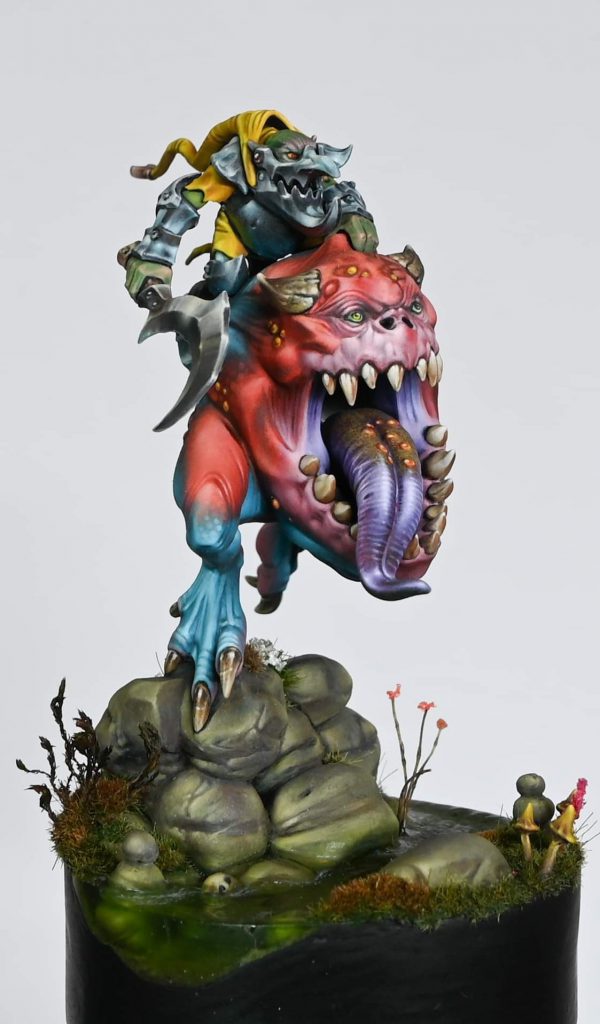
It was a mistake actually, because my painting has changed a little bit since then, and I had other ideas on what I wanted to do with it. So I actually ended up repainting a lot of it anyway and there were some things on it – I originally had given him a lance with a pennant on the end that was trailing back. It covered most of the face on the model – bad idea even if the free hand looks alright, it’s still dropping a lot of the model. So I took that off, put the other weapon on with the little sickle on and like some nice non-metallic on there with a little shine spot.
Then I was looking at the squig, and it’s got very smooth curves all over it and not a lot in the way of edge highlights and I don’t really paint Eavy Metal style anyway, so I pushed all the soft blending on that. I went a little bit over the top in terms of color transitions because it has a pink face and a red body and a blue bum and underside. Then he’s got a little pink on the back of his bum as well and also pink feet.
So it was quite a challenge to make all these colors blend together, because if you’ve got red and blue and you want to transition them, you usually think about mixing the paint. But you can’t, because you’re going to get purple. So you need an intermediary mix. What I did was I used the light hitting the model. I took the red and added a load of white to it. It was a bit of yellow as well. So it’s pale pinky-orange and almost baby blue, almost very similar in tone. So then I glaze those together for the highlights and it makes it blend a bit better. But it took a long time to make it all work.
Originally when I painted the rider as well, I started putting loads of details on him. I put black flames coming off his hood and I put little pink spots on his green skin – looking at it, I thought I had gone a bit over the top on details. It’s only a tiny little model. So I simplified it all down to a simple yellow hood. I say I painted simple non-metallic armor, but the armor’s quite complicated. It has all reflections and things on it, but it’s still very straightforward for me to do in terms of color choices. It’s not too messy when you look at it, everything looks very clean. That’s what I was going for.
Then I put the models on the base. I sculpted some rocks and put them on the base. I spent ages painting the rocks and then I put a little resin water effect at the bottom and had a disaster with it. I put dams all around it like it’s all ready to go. I made the stupid mistake of putting lots of grass tufts on a little flat area on top and as soon as the resin touched the grass tufts, it sucked into them, flooding the entire base. It took all the resin out of the water area, went over the sides of the dams all down. I was like, oh no, it’s gonna stick to whatever I put it on so I had to raise it up onto little blocks and all the resin went underneath. So the bottom, it wasn’t flat anymore.
It was an absolute nightmare and this is a week before the competition. I planned to do an Adeptus Titanicus titan for it. I didn’t have time to do it because I had to fix the base, so I was a bit disappointed about that. It took me a few days of sanding just to clean it all up. Fortunately when the resin was drying, I had a little bit spare that I’d left and it started to set a bit so I poured that in as well. I know that sounds a bit crazy when it just flooded the whole thing, but I poured that in as well. Because it was a lot thicker, it didn’t have the same effect and it just stayed where I put it. So that saved it, but it would have been more helpful if I could have got it right the first time.
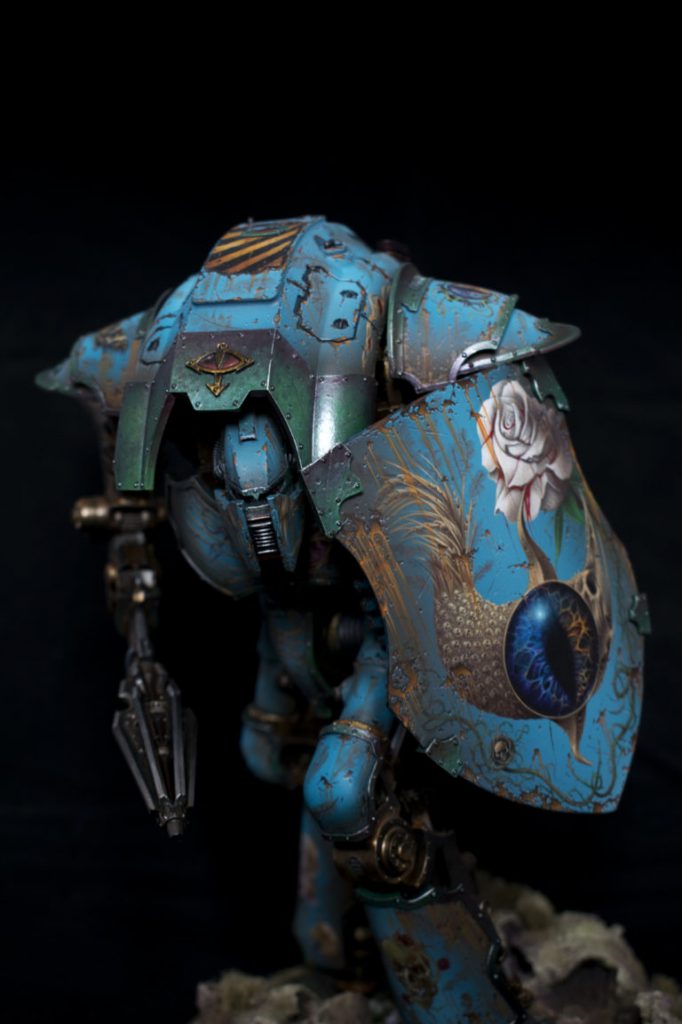
GH: What would you say your strength is as a painter and what are you trying to highlight with your entry?
RG: I’m quite good at freehand because the training as an illustrator helps with that. Although it’s not as direct of a translation as people might think, because obviously when you’re doing a drawing or painting it is quite big. So it’s a different movement when you have to do it a couple of centimeters big compared to like an A4 picture. I also really enjoy non-metallic metals. Again as I say it’s painting, but I like to try and make metal look like metal. I also like dramatic lighting. I’ve got a bit of that actually on the squig, so it’s quite strong with light and non-metallics on it. It’s the first model really where I’ve gone for quite strong, smooth, clean blending. I usually prefer a more heavily textured kind of look to my models, which is quicker to do as well. You can hide a lot of faults with texture work.
With the really smooth blending, even a tiny tiny imperfection is obvious because everything else around it is very clean. So I tried to do that. I think it’s turned out alright – we’ll see how it does it obviously in the competition. It was the first time for me and I don’t think I’ll do it again because it just takes too long. It takes a long, long time for that kind of blending. I could have had three really good entries of something else. I could have had a nicer titan instead.
GH: Was there anything specific about the choice of model?
RG: I loved night goblins originally. He’s a really cool like night goblin model. I like the dynamics of it. I converted it a little bit. So in the original model, both the legs on the squig are kind of like flying backwards and that’s where it is attached to the base by some mushrooms. I rotated the legs so he was running forward, which caused a little bit of an issue because he didn’t actually have anything to pin him to on the base and he didn’t have any flat feet or anything like that.
So I had to pin into his claw which was rotated and like a raptor claw. I had to put pins in that, but then you can still see them because there’s no flat base to it. So I had to sculpt a rock around the pins into his foot. Sometimes interesting ideas create awful problems. I just love night goblins.
GH: So in terms of the concept was it an idea that you’ve always had in mind when you first saw the model?
RG: Goblins are really nice because they have exaggerated features. So they’re tiny little models, in theory they shouldn’t take that long to paint, but they have big features: big eyes, big nose, and big hands. Those tricky details to paint are a little bit easier even though it’s on the small model.
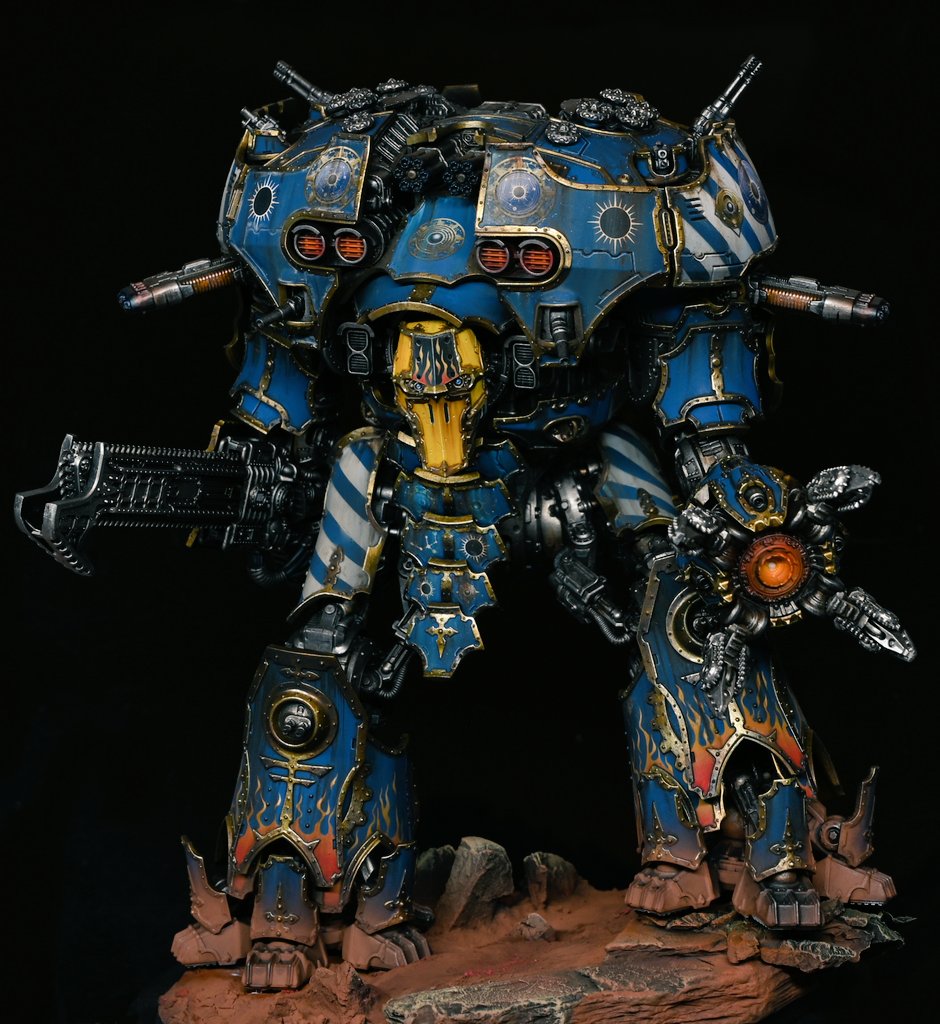
GH: Okay, so that was just the main entry?
RG: The other thing was I put in a Warmaster titan for Titanicus. This was one that was sent to me by Games Workshop. It’s the Iconoclast and I painted this quite quickly. It was more of a case of, “I should enter something else” and I liked the model to be honest. I shaved off the details on the carapace armor at the top – he’s got the scroll work on it – I shaved all that off and put decals on there instead. And I think that actually looks a little bit nicer to just give the model a bit more sort of breathing room with a flat surface. I do think sometimes maybe they put more detail on than maybe it needs to be. I know it makes it easy to paint, in terms of army painting.
Things you can dry brush and wash – like contrast paint works really well on heavy detailed services – but I prefer smooth surfaces and I know they can’t make models for me, but having just clean areas. Just give me a bit more space to have some fun.
GH: So, of those entries, which one do you feel has the strongest position to play?
RG: So, I don’t know actually because the Age of Sigmar category is really, really, really hard and there are loads of Slayer Sword winners entered into that category. Whereas the small scale one, not as hard, not saying that the win won’t be good, but it’s also a newer category as well. So people aren’t quite familiar with it. I don’t think people actually quite understand what can be entered in there either. So, it could be anything from the old Epic. I think probably this squig has a better chance, but they’ll probably both be finalists and we’ll see how we go.
GH: While you’re working on your entries, how do you deal with burnout?
RG: I don’t have the luxury of burnout because it’s my job as well, I just power through it. The thing is, the only hobby burnout I have is in terms of if I’ve done too many hours in a day and I get really tired, I have a little break and then I get back to work. But I enjoy painting – I feel so lucky with my job. So privileged for what I do. I just enjoy it. It’s not really a problem.
GH: When you’re working on the entry, do you tend to work on anything else?
RG: The last couple of weeks I’ve just done purely on the Golden Demon stuff, which is a bit of a pain because I should really be putting out content as well. I just couldn’t do both at the same time. I really need to focus on the Golden Demon and then I’ll just catch up afterwards and hopefully people won’t mind too much. Before that I was working on both things and Games Workshop was still sending me some new things. I started on the Leagues of Votann so I’ll be able to show some YouTube videos for those soon. But also the thing is, I’m planning other Golden Demon entries and I’ve already got those in the back of my mind. I’m actually going to do another AT titan and this is gonna be a tiger eyes titan, but it’s gonna be a Nurgle one, Nurgle corrupted and I’m going to get like some blight drones and chop those up. It’s all going to be freehand as well, a proper entry, not a game piece.
GH: Amazing, looking forward to that one. So when you’re working on these entries, how do you know when to stop?
RG: You don’t, you never know, it probably gets to a stage where you’re messing around on it and then you risk the chance of damaging what you’ve already done. Then you think, right, it’s just not worth it anymore.With this squig, I was looking at it and thinking because we didn’t actually get that much notification before this Golden Demon either, so it was a bit of a rush. Taking months to paint something is not really a rush, but I prefer a longer time to get something done.
To side track a little bit when they were doing the smaller Golden Demons at Warhammer World, they did one every year, multiple ones a year even. I was doing those all the time and that was leading me to burn out because you’re constantly trying to paint a model for a trophy and that was quite tricky. So actually when they stopped doing those, that was better because I really admire people like David Soper where it just takes a long time and you can just refine it and you get a lovely thing at the end. Now it’s not great for me as a business, I can’t just pick one model and take three or four years or whatever to paint it. I think for some of my entries I might take more of that kind of viewpoint for them. So just do them really slowly and if they’re done they’re done. If they’re not, I don’t enter that year.
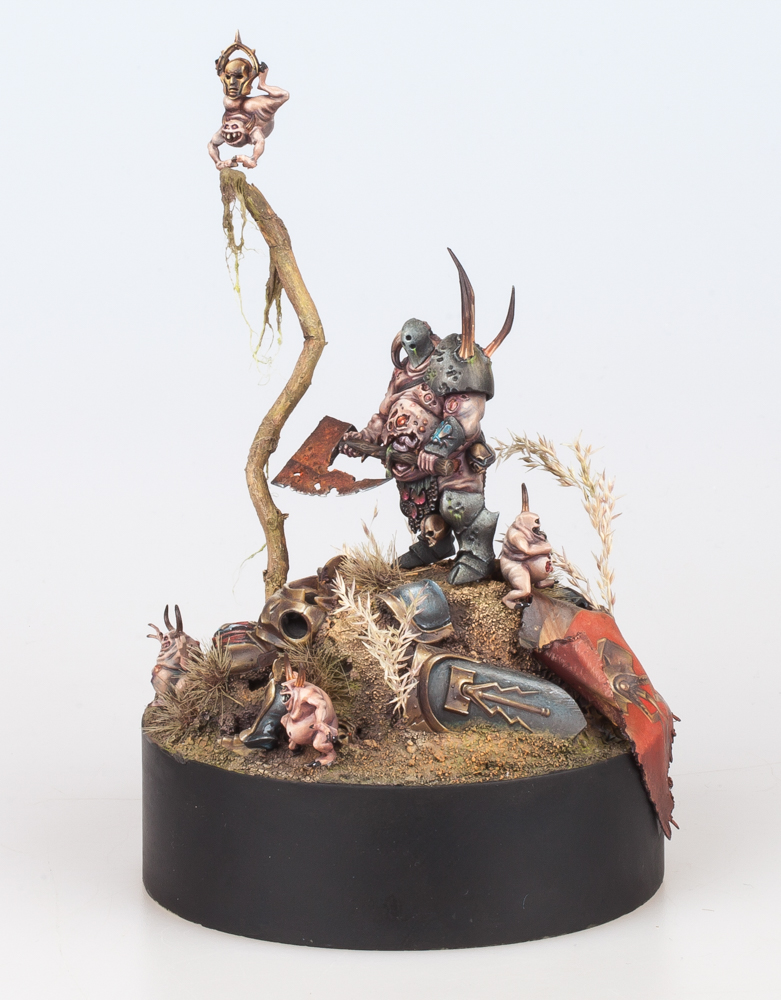
GH: That’s fascinating. Moving on to advice that you give to others, what’s your favorite shortcut painting cheat and do they or do they exist?
RG: No, there’s no shortcuts for Golden Demon – You can do shortcuts for social media posts. Maybe not spend as long on the back of something.
Actually, my favorite thing is Frank Frazetta. If you look at his work, you’ll see that he’ll have areas of focus on the painting and then as you go further away from that the focus is less worked. You can do that on model painting as well. It actually looks really cool because most people, when they look at the model, they look at the focal point – they look at the head and the chest area. No one cares about their feet, so there’s no point unless you’re doing a competition entry to spend that much time on those. Even then you could do it as a competition thing in terms of focus with the light, dramatic lighting, making it all go onto those bits. That would be the area where you spend the most time on it.
It’s important that people understand that they don’t have to paint like Eavy Metal. There’s always these rumors that you have to paint like box art to win. It’s not true. It’s never been true. People see that, “I think that’s what they want” and everyone goes with that. So that’s what people do and then some of those entries win and people say “Look, that’s what you need to do to win”. So it’s circular of course.
GH: What technique or approach do you wish that you learned sooner when you started?
RG: Working with paint consistency. There’s always been a thing with Games Workshop – two thin coats. That’s not competition painting, that’s for clean army painting. Paint consistency varies entirely depending on what you’re doing. If you’re doing glazing, you need really thin paints, you want to do some heavy texture work – you probably need to paint a bit thicker. It’s a vast array of different consistencies that you need for different things that you do. I wish that that had been more obvious to start with – because when I started it was just White Dwarf, that was it. And the only painting guys they had were in White Dwarf, so that was it – Eavy Metal style. You could see the Golden Demon winners, they weren’t painting like that, obviously, but you didn’t know how they did it.
GH: When we talk about the competitive painting community, is there any technique or approach that you feel that they tend to over fixate on?
RG: Yeah, non-metallic metal, OSL, freehand, they think those are what win trophies, you don’t need to do that. In previous years where we’ve won trophies – and we have a little winners day – the judges will give us advice, or talk about what wins, and they’re telling us “You don’t need to do these things”. As long as you get something that just looks good, follows the Warhammer I.P, that’s enough that you can win your trophy.
If you take freehand, and you do a good freehand, but not as super neat as a decal, that will probably get marked lower than something that’s a perfectly done decal. I know people go a little bit crazy when they hear that because it’s a lot harder to do freehand than it is to do a decal – but it’s how it looks, it’s the result that counts, not the process. You can use true metallic, glitter paint as we like to call it – you can do that really well. That will have an equally valid chance.
GH: Are there any other words of wisdom you give someone considering entering?
RG: The big thing is people get really nervous about entering. I get not-so-much nervous because I know what goes on, but still I get anxious – it’s quite stressful in the build up. If you have not entered before and you don’t know any of the people – the problem is when you’ve won a few trophies and all go to the same events, you talk to everyone online, so we all know each other. You might see us in little groups and think, “oh, they’re all talking to each other. I don’t know. Yeah, I can’t go and talk to them”. You can, you can come and talk. We’re all friends here, we’d like to chat, we don’t want to exclude anyone. We’re very encouraging for people to enter the competition and once you’ve done it once or twice, you know what it’s all about, people will recognize you. It’s like joining a club, because we’re all excited to see the models and things.
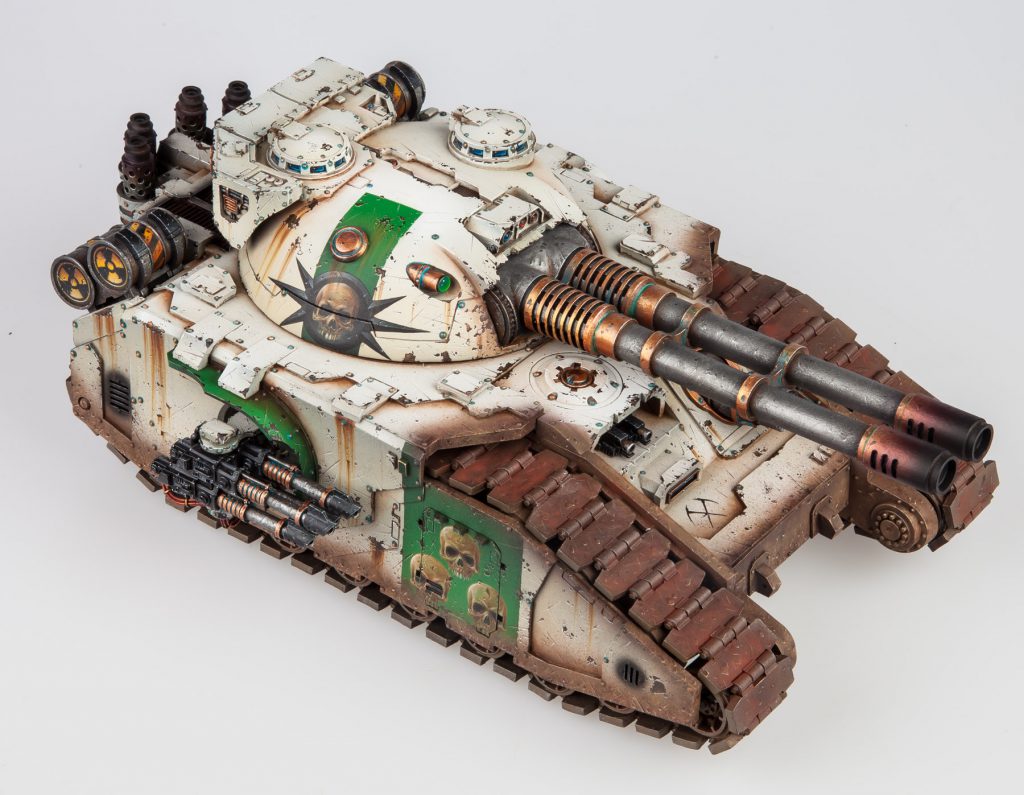
GH: This ties into what you just said, but do you still suffer from imposter syndrome? Is that something that you suffer from? How did you overcome that?
RG: Well, I’m quite pigheaded. Part of the problem is unfortunately down to things like Instagram. I don’t want to say that people photoshopped their work, but when people are taking photos, models look different than what they look in the flesh. This is particularly relevant to non-metallic metal style painting because that can look incredible in a photograph, but unless you’ve done it really well, it can look very rough in real life. Sometimes the actual rough painting will look even better in the photograph. The problem is when I’m trying to work for a competition, I use the standard that I see of high level painting on social media. That’s the standard I’m aiming for, but it’s an unrealistic standard. You’re always full of doubt, but you need that to be able to push yourself to have that high level. It is important that people understand when they look at some of the pictures on social media, they don’t look like that in the flesh..
GH: Where are people best to find you online and see your work?
RG: Well, if you just type my name in – Richard Gray – it will come up. I’m @daemonrich on Instagram. Same again on Twitter, Richard Gray on Patreon.
GH: It’s been an absolute pleasure. Thank you.
We’d like to thank Richard again for taking the time to talk to us and sharing this with you all.
